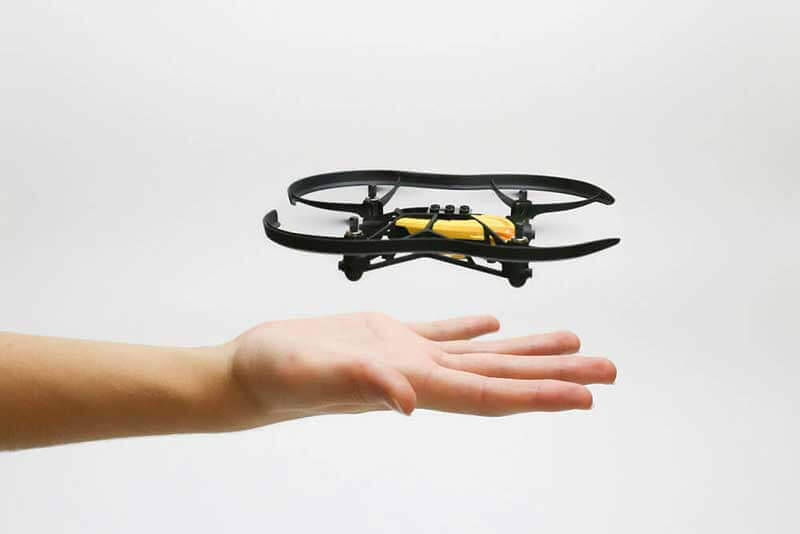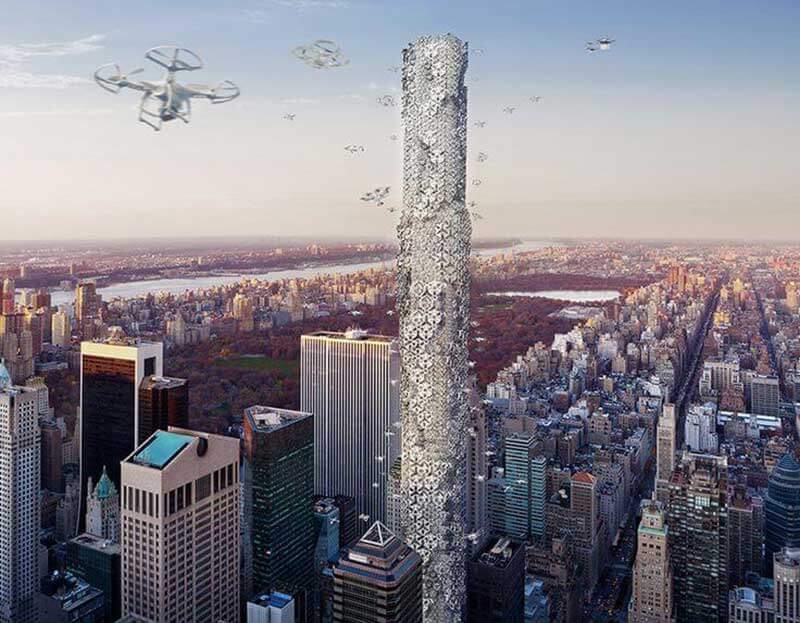- The appeal of mini drones – not even the sky is the limit
- Mini selfie drones: detach, throw, action!
- Mini PokéDrones can help you catch them all
- Training eagles to take down hostile mini drones
- Where will all those thousands of drones dock and charge in the future?
- When the drone market reaches a plateau
Quadcopters, UAVs or drones have become increasingly common and popular over the past couple of years. While initially designed for military operations to minimise the deployment of human soldiers in dangerous and remote locations, drone technology has also found its way onto the consumer market where it has been causing quite a stir. Especially thanks to the availability of cheaper models. According to retailers’ estimations, hundreds of new drones hit the market every month.
The appeal of mini drones – not even the sky is the limit
Mini drones have endless uses and can perform a myriad of services. A team of researchers in Zurich choreographed a group of mini drones to weave building structures while other drones have been deployed to detect graffiti vandals at railway stations. Mini drones are used by the paparazzi to spy on celebrities and Mexico’s drug cartels use them to smuggle drugs across US borders. (Which deliveries generate an estimated $2 million in narcotics sales per flight, by the way). Scientists use them to keep track of the environment by testing the makeup of ozone, checking air quality and monitoring environmental violations such as illegal dumping. Mini drones can be used to inspect oil rigs, transport medicine and… entertain hobbyists. Not even the sky is the limit.
Mini drones for leisure use have become popular gift choices and come in all sorts. They can fit in your hand and fly indoors, taking pictures at family get-togethers, birthday parties or other social events. Then there’s the slightly larger drones, that can take footage as you surf the waves, climb Everest or take your new motorbike for a spin. One thing’s for sure, the latest consumer drones are evolving into much more than remote-controlled, flying robots. The new generation autonomous drones can be programmed to do exactly what you want them to do. Whether it’s maintaining a particular distance, angle or height or follow a pre-determined flight path for the best footage.

Mini selfie drones – detach, throw, action!
The latest mini drones are attentive, even loving toys that can be programmed to take snaps of you from the most flattering angles. They are the ultimate in flying selfie sticks. The Lily Camera drone was developed by Berkeley’s robotics lab in California. It is focused on the user with a camera that can be trained to follow you around using a GPS tracker. The Lily Camera has a computer vision system through which it learns to recognise your face. This way, it can be taught to perfectly position your face in the lens at all times. You throw the Lily in the air and the flying camera will follow your every move, snapping high quality pictures or taking video as you go. The pocket GPS will let the Lily know when you fall or jump and you can direct the drone to fly further or closer to you, or to your left or right, while keeping you locked in the lens. This flying camera takes photography skills to a whole new level, without any real input from the user. The final 3D-printed version of the Lily Camera will be throw proof and waterproof. It can be tossed into the river or the sea and float or take off from there. When you throw it into the air, sensors such as a gyroscope, magnetometer, accelerometer and a ground-facing camera will make sure the drone stabilises itself and doesn’t get blown away. The Lily is even able to record audio through the tracking device. It has a 20-minute flight time and as soon as the battery runs low, it automatically lands itself, unless the user docks it in time.
Another incredible selfie drone is Nixie, $550,000 grand prize winner at the Intel’s Make It Wearable Challenge. This super small wearable drone with a swivelling 1080p camera straps to your wrist and when the user is ready to take a selfie, just a flick of the wrist will make Nixie detach and fly off. It then turns around and takes photos, before returning to the user’s wrist. Nixie’s CEO Christoph Kohstall calls it the ‘boomerang mode’. When someone else with the same device is in close proximity, the mini drone still returns to the rightful owner, as each Nixie has a unique identifier.
Mini PokéDrones can help you catch them all
Many companies are frantically trying to find ways to jump on the Pokémon GO bandwagon. Dutch design firm TRNDlabs has developed the PokéDrone, a mini drone that helps PokéHunters catch them all – easier and faster – especially the rare, out of reach species. Measuring only 4 cm from blade to blade, the PokéDrone is especially useful when Pokémon are hiding in the middle of a hard to reach area. The device acts as an external camera and captures Pokémon when you can’t – by using the PokéDrone’s camera instead of the smartphone’s. With the device boasting auto take-off and landing functionality, players don’t need to be drone flying experts. TRNDlabs is hoping to collaborate with Nintendo directly as it owns a third of the Pokémon company, even though it didn’t develop Pokémon GO. While the PokéDrone is still in its development stages, Gerard Nieuwenhuis, founder of TRNDlabs, stated that it should be ready to hit the market early 2017.
Training eagles to take down hostile mini drones
Apart from all the entertainment value they bring, mini drones are also known for their unscrupulous and criminal uses. The Metropolitan Police Force in London have now shown an interest in using trained eagles to snatch mini drones from the sky in a bid to address growing concerns about drones infiltrating prisons. The Ministry of Justice reported that in the first five months of 2015, there have been nine attempts to use drones for prison infiltration in the UK and Wales. Drones have also been involved in various near-collisions at a number of airports in the UK. Guard From Above, a Dutch company, have been training these magnificent birds in such a way that they see mini drones as prey. The eagles have already been deployed to catch drones of various sizes in mid air. The birds do this by grabbing the drones in the middle, in between the rotors. The idea of using eagles to catch these drones has, however, been met with criticism. Conservationists in the UK are of the opinion that the big, powerful birds should not be flown in urban areas and that the rotating blades could cause serious injuries. The US National Audubon Society have however commented that the birds are perfectly capable of avoiding the rotors. They have incredible visual acuity and whack the drones right in the middle.
Where will all those thousands of drones dock and charge in the future?
Whether used for leisure or commercial purposes, mini drones are here to stay and they will become an increasingly familiar sight. The proliferation of these buzzing bots can however become a problem, especially in built-up areas, as they all need a platform for landing and take-off. Mechanical engineer Charles Bombarier from Quebec, Canada, founder of futuristic design blog Imaginactive, has some pretty interesting ideas about what the buildings of the future should look like. In order to accommodate the hundreds of thousands of drones that are going to be part of our daily lives, we will need to build high-rise structures featuring multiple, large balconies with strips to land mini drones, hover boards and other personal aerial vehicles. Tall apartment blocks could also boast robotic furniture that automatically makes room when it detects a delivery drone approaching. Of course we would also have to have urban air traffic control systems and safety features in place around these futuristic buildings.
As part of their course at the University of Pennsylvania, Hadeel Ayed Mohammad, Yifeng Zhao and Chengda Zhu designed a 423-metre concept sky scraper – the Hive – custom built with drone docking and charging stations. Swaths of drones would be buzzing around the high-rise structure, making it look like a giant beehive. The students’ architectural plans place the Hive in the middle of Manhattan, New York, with the intention of creating a landmark in the shape of an enormous drone depot. The design could one day serve as a major logistics/commuter hub, where the swarms of electronic devices that carry the goods, information and people of the future can be stored, maintained and charged.

When the drone market reaches a plateau
As more and more drone manufacturers start to flood the market with cheap drones, from mini toys that cost only $10 to camera carriers of $100, the market is very likely to plateau at some point next year. Many people will buy a mini drone which will eventually end up in an attic somewhere. Much like Apple is doing for their iPhones, drone manufacturers are now increasingly focusing on kits that enable developers to write custom applications for particular tasks.
Share via:



